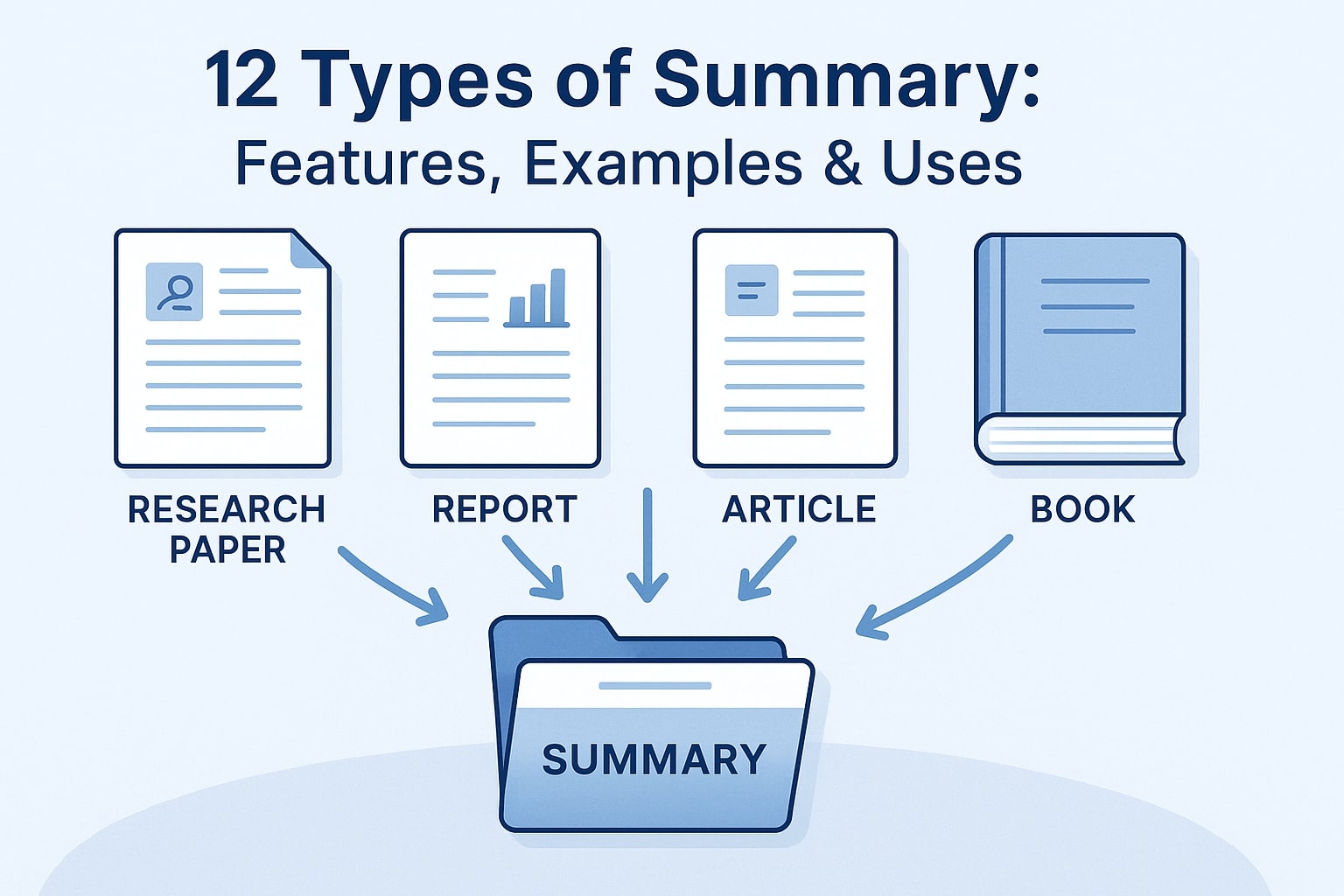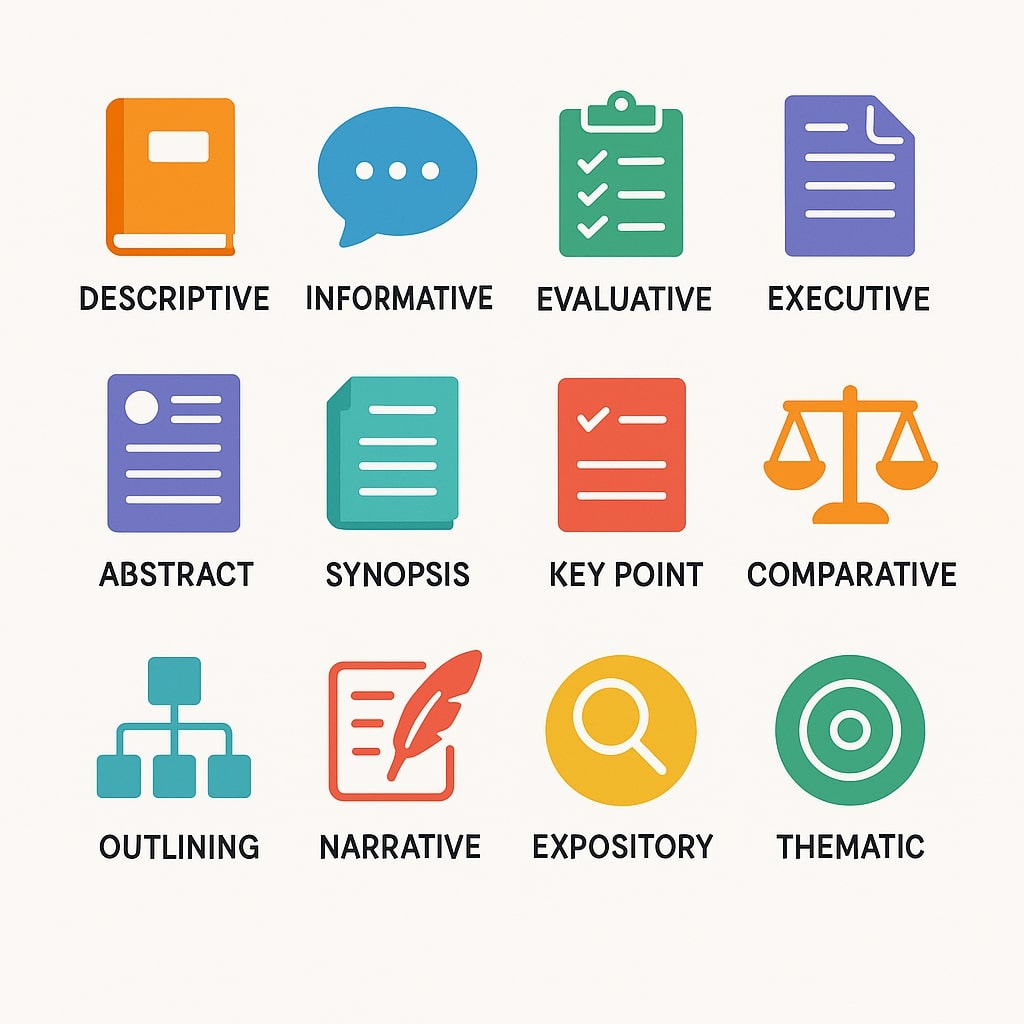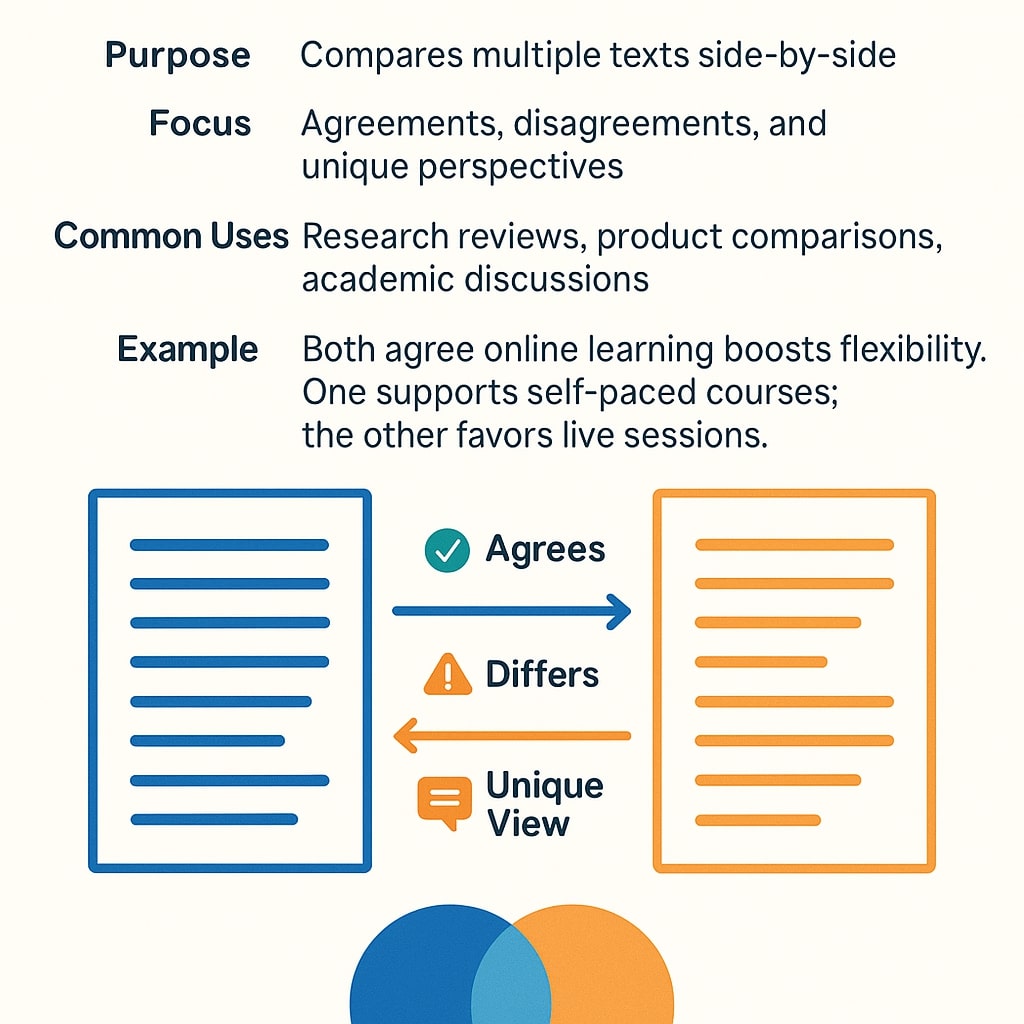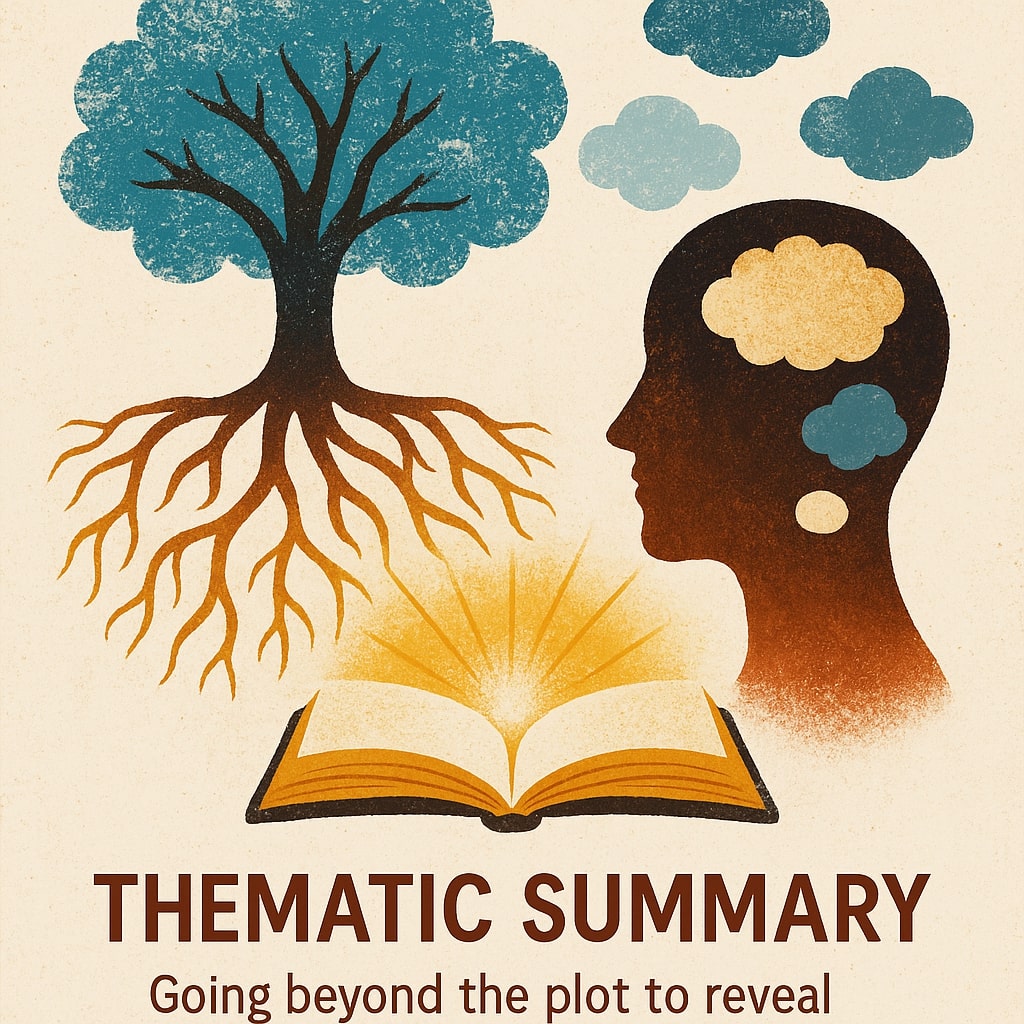12 Types of Summary: Features, Examples and Uses
This article breaks down 12 types of summaries with easy examples and clear uses.
Today, we consume more information than ever. Whether through articles, reports, research papers, or social media.
According to Venngage, a human brain can process 74 gigabytes of information in a day. This is around 200,000 words. But right now, we process about 34 gigabytes of information daily.
With so much data coming at us, we forget most of it. That’s why we need summaries to at least remember the core idea.
I still remember the first time I had to summarize a 20-page research article for a school project. I was overwhelmed—what do I keep, what do I skip, and how do I make it useful for someone who hasn’t read the full text? That’s when I realized: not all summaries are the same.
From executive summaries for decision-makers to abstract summaries for academic papers, each type serves a unique purpose.
In this article, I’ll talk about 12 types of summaries, how they work, when to use them, and what makes each one effective.
12 Types of Summary: Features, Examples and Uses
Here are the 12 types of summaries you can use to present large information clearly, depending on your purpose and audience.
1. Descriptive Summary
A descriptive summary gives a quick overview of what your original content is about without going into the details of arguments, outcomes, or conclusions.
It’s like giving someone the table of contents in sentence form. It tells what to expect without spoiling anything.
This type of summary works best when you need to introduce a document or help someone decide whether they want to read the full version. You’ll often find it in research abstracts, course outlines, or at the beginning of reports and papers.
You do not add analysis or evaluation in a descriptive summary. Instead, mention the topics you’ve covered, the purpose of your work, and sometimes the structure.
Here’s a quick example. Suppose you’re summarizing a research paper on social media marketing. A descriptive summary might read like this:
- “This study examines the impact of social media marketing on small business growth, focusing on customer acquisition, brand recognition, and sales conversion in various local markets.”
This summary gives you a sense of the content and scope but leaves out the results or conclusions.
2. Informative Summary
An informative summary goes beyond just describing the content. It tells your main ideas, arguments, and conclusions. Think of it as giving someone the highlights so they do not need to read the entire piece.
We commonly use this type of summary for academic papers, news articles, and research reports. It answers questions like what your main idea is, what evidence supports it, and what your final outcome or message is.
Unlike a descriptive summary, this version includes key facts, findings, or arguments from the original text. It’s useful when your readers need to understand the core message quickly and accurately.
For example, if you’re summarizing a research article on remote work, an informative summary might look like this:
- “This study revealed that social media marketing significantly impacted small business growth. Participating businesses reported an average 28% increase in customer acquisition and a 40% improvement in brand recognition over a six-month period.”
It delivers both what the study is about and what it concluded.
3. Evaluative Summary
An evaluative summary doesn’t just present the main ideas; it also includes the writer’s opinion about the quality, value, or effectiveness of the original content.
It's a mix of summary and critique.
You will find this type of summary in book reviews, article critiques, or when you're asked to analyze a piece of writing rather than just report on it. It helps readers understand both what the original work says and how well it says it.
What makes an evaluative summary different is the judgment it includes. You can add your comment on the strengths, weaknesses, clarity, bias, or usefulness of the material.
Here’s how it might sound when summarizing a documentary:
- “This film shows clearly how bad plastic pollution is, using real, touching stories to make you care. Even though it could have given more facts, its strong pictures and clear message make it a very important film to watch.”
This example not only tells what the documentary covers but also evaluates how well it does it.
4. Executive Summary
An executive summary is a short version of a longer report. It is made specifically for decision-makers who don’t have time to read the full document.
It presents the most important information, including the purpose, key findings, conclusions, and recommendations.
You’ll usually find this type of summary at the beginning of business reports, proposals, or strategic plans. It allows stakeholders to get the full picture quickly, without diving into every detail.
Unlike a simple overview, an executive summary is structured like a mini-report. It often mirrors the full report’s structure, but in a much shorter format. It also avoids technical jargon, so it's easy for a non-expert to understand.
Here’s an example of a marketing report:
- “This report looked at how our marketing efforts helped grow sales for our new product, GreenClean, last quarter.
We found that our online ads reached many people. Social media ads reached 500,000 people and led to 100 sales. Google Search ads reached fewer people (50,000) but led to more sales, with 250 units sold. In total, we sold 350 GreenClean units.
This means Google Search ads were better at turning clicks into sales. For the next quarter, we suggest putting more money into Google Search ads and making our social media ads work harder to get direct sales. We should also look at our pricing based on customer feedback.”
This summary gives the result, key data, and what action is needed—all in a few lines.
5. Abstract Summary
An abstract summary is a brief version of a research paper or academic article. It is typically found at the beginning of scholarly publications. Its main goal is to give readers a quick understanding of your study’s purpose, methods, results, and conclusions.
You’ll see abstract summaries used most often in journals, dissertations, conference papers, or scientific reports. They help researchers decide whether the full paper is relevant to their own work.
Unlike other summaries, an abstract is usually formal and follows a clear pattern. You explain what your research is about, how it was done, what was found, and what it means. It's often written last, even though it appears first.
Here’s an example of what it looks like:
- “This study looked at whether fitness apps with games (gamified) help young adults exercise more. We followed 200 young adults for 12 weeks, some with a gamified app and some with a basic tracker. People using the gamified app exercised more often and felt more motivated. This suggests that adding game-like features to fitness apps can help young adults stick to their workouts.”
In just a few sentences, this gives you the topic, method, result, and takeaway.
6. Synopsis
A synopsis is a condensed version of a story, script, or narrative. You outline your main plot points, characters, and key events you have used in creative fields like filmmaking, publishing, and storytelling.
Writers usually prepare a synopsis to pitch a novel to publishers or submit a film idea to producers. It helps the reader understand the storyline without reading or watching the entire work.
Synopsis is different because of its narrative flow. You have to write the story from beginning to end. But only revealing the twists, climax, and sometimes even the ending. Without any fluff. Especially when used to pitch an idea.
Let me write a quick synopsis example of Harry Potter:
- “A young orphan discovers he’s a wizard and attends a secret school of magic. Along the way, he makes loyal friends, faces dangerous enemies, and uncovers the truth about his past and a dark wizard threatening their world.”
This version gives you a full picture of the plot in just a few lines.
7. Key Point Summary
A key point summary highlights only the most important ideas or facts from a longer text. It strips away the details and examples you give. And focuses purely on your core takeaways.
This type of summary especially helps you for quick reviews, study notes, meeting recaps, or briefing documents. You can have the main message without reading everything line by line.
A key point summary is often written in bullet points or a numbered list. That’s to make it direct, easy to scan, and perfect when you're short on time.
Here’s a key point summary for a blog post about healthy eating:
- Eat more whole foods like fruits, vegetables, and grains
- Avoid processed snacks and sugary drinks
- Plan your meals to stay consistent
- Drink plenty of water throughout the day
You can see that each point captures a main idea from the original content, helping you remember what matters most.
8. Comparative Summary
A comparative summary reviews two or more texts side by side. You don’t have to summarize each one separately. You can just compare their similarities, differences, perspectives, or conclusions in the same paragraph.
These summaries are commonly used in literature reviews, product comparisons, research overviews, and academic discussions where multiple sources are involved. It helps your readers understand how different ideas or findings relate to one another.
In this summary, you highlight where sources agree, where they conflict, and what unique angles each one brings. It’s especially useful when you're analyzing trends, opinions, or competing theories.
You can summarize the comparison of two articles on online learning like this:
- “This report compares two popular smartphone brands. While both offer high-quality cameras and long battery life, Brand A stands out with its user-friendly operating system, while Brand B offers more advanced customization options for tech-savvy users.”
This way, you give a clear comparison without going into full detail for either source.
9. Outlining Summary
An outlining summary presents the structure of the original text in the same order it appears, but in a much shorter form. Like a map, showing the main headings, subpoints, and flow of your content.
You can use it for textbooks, lectures, reports, and essays. Your readers will see how you’ve organized content and how the ideas connect from one section to another.
Instead of writing full sentences, an outlining summary is a nested list similar to a table of contents but with a bit more detail.
If you have a report on renewable energy, you can summarize it like this:
Introduction
Importance of renewable energy
Types of renewable sources
- Solar
- Wind
- Hydroelectric
- Challenges
- Storage limitations
- High initial costs
- Future outlook
- Policy changes
- Advancements in technology
Doesn't it give you a clear, organized view of what the full report contains?
10. Narrative Summary
A narrative summary describes the main events or storyline in the order they happened. It's commonly used for summarizing novels, films, historical accounts, and real-life stories.
You focus on plot development, character actions, and how one event leads to another in this summary.
You need to keep the story's flow intact but skip minor scenes and unnecessary dialogue. So, use it when you want to give someone the essence of a story without unnecessary detail.
For example, summarize a short story like this:
- “Leo, a street artist, finds a magic paintbrush that brings his art to life for a short time. He uses it to create a powerful mural that inspires his community to save their homes from demolition, learning art's true power to unite people.”
This summary keeps all the events in order and conveys your narrative arc without deep analysis.
11. Expository Summary
An expository summary explains the main idea of a non-fiction text in a clear and factual way. It provides textbook information rather than telling a story or giving opinions. With this, your goal is to clarify what the original text is trying to teach or explain.
You’ll often find expository summaries in textbooks, instructional guides, informative articles, and essays. They are used to highlight key points, supporting details, and how the information is organized.
Avoid giving your personal opinions or interpretations in it. Because it’s meant to be neutral and focused on helping someone understand the material quickly.
Like if you have to explain respiration to someone, you can do it like this:
- “Respiration is how living things get energy and exchange gases. It involves breathing, which brings in oxygen and releases carbon dioxide, and cellular respiration, where cells use that oxygen to break down food for energy (ATP). This process is vital for all life functions.”
It doesn’t retell the content word-for-word—it gives a clear explanation of the core message.
12. Thematic Summary
A thematic summary focuses on the central themes or messages in a text rather than on the structure or specific events. Means it identifies your ideas that tie the content together. Especially useful for analyzing literature, essays, speeches, or opinion pieces.
You summarize beyond surface-level details in this summary. So, highlight what the work is really about at its core, such as love, justice, identity, freedom, or change.
You’ll often see thematic summaries used in classrooms, book reviews, and literary analyses where interpretation matters as much as information.
Here’s a thematic summary of a novel about war and memory:
- “This story explores how war deeply scars memory, suggesting that true healing and peace emerge only when individuals bravely confront and integrate their fragmented past experiences.”
The summary doesn’t recount every event but brings out the deeper meaning behind the story.
Conclusion
Summarizing isn’t just about shortening your content. It also focuses on what matters most in your words.
Whether you want to draft a business report, analyze a novel, or review a research paper, you need to choose the right type of summary.
Each summary serves a unique purpose. They are made according to the information you're working with and the audience you're addressing.
By understanding these 12 types of summaries, you can present ideas more clearly, save time, and communicate with more impact.
You can also use an AI summary generator. It can help you draft any type of summary faster. Whether you want it on academic content, reports, or blog posts, summary-generator.net has a mode for every type of summary.
Learn how to write summaries in different styles and make every word count.





